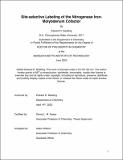Site-selective Labeling of the Nitrogenase Iron-Molybdenum Cofactor
Author(s)
Badding, Edward D.
DownloadThesis PDF (19.26Mb)
Advisor
Suess, Daniel L. M.
Terms of use
Metadata
Show full item recordAbstract
Nitrogenases are enzymes known to catalyze the kinetically challenging, and biologically important, reduction of N₂ to NH₃. The mechanism of these enzymes, and in particular, the chemistry that occurs at the catalytic cofactor of the Mo nitrogenase, the iron- molybdenum cofactor (FeMo-co), has been studied for decades. A challenge in understanding its unique reactivity is knowing how the valence electrons of FeMo-co are distributed and coupled, and how those change during catalysis. Because the large number of metal sites present within FeMo-co gives rise to a complex set of spectroscopic responses, correlating that information to a specific metal site within the three- dimensional structure is a substantial challenge. My thesis is focused on addressing this problem by incorporating ⁵⁷Fe site-selectively within FeMo-co—specifically its terminal Fe site (Fe1). Spectroscopic analysis of the site-selectively labeled Mo nitrogenase in its resting state informed on the valence and spin orientation of the Fe1 site, and as a result, ruled out multiple proposed spin-coupling schemes for the entire cluster. Characterization of the oxidized resting state and the first intermediate of nitrogen fixation provided insight into the cofactor’s redox chemistry, and established the utility for using this methodology to study other states of FeMo-co. Finally, the methodology to site-selectively label FeMo- co was expanded to manipulate its chemical composition by substituting the Fe1 site with Co²⁺. Incorporation of this new artificial metallocofactor into the Mo nitrogenase and its subsequent characterization revealed that, within the same charge state, CoFeMo-co is EPR active for states that are EPR silent in the WT enzyme. This work opens the door for studying these states using advanced EPR techniques or magnetic Mössbauer
spectroscopy.
Date issued
2023-06Department
Massachusetts Institute of Technology. Department of ChemistryPublisher
Massachusetts Institute of Technology